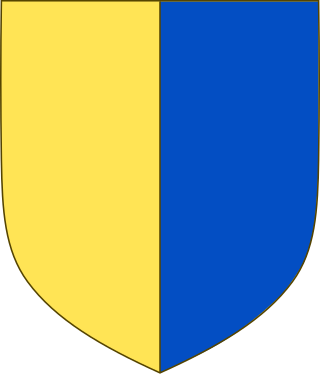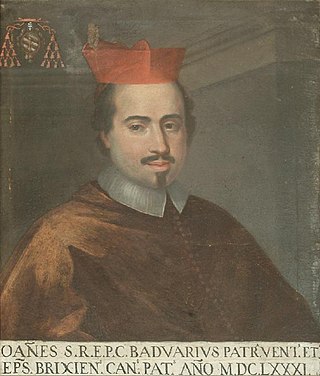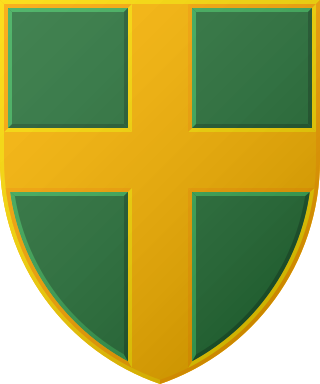

The Badoer were an aristocratic family in the Republic of Venice. The Badoer traced their ancestry, without any factual basis, to Doge Giustiniano Participazio in the early 9th century. In fact, they rose to prominence in the 13th century. [1]


The Badoer were an aristocratic family in the Republic of Venice. The Badoer traced their ancestry, without any factual basis, to Doge Giustiniano Participazio in the early 9th century. In fact, they rose to prominence in the 13th century. [1]

The Patriarch of Venice is the ordinary bishop of the Archdiocese of Venice. The bishop is one of only four patriarchs in the Latin Church of the Catholic Church. The other three are the Patriarch of Lisbon, the Patriarch of the East Indies and the Latin Patriarch of Jerusalem. Presently, the only advantage of this purely formal title is the bishop's place of honor in papal processions. In the case of Venice, an additional privilege allows the patriarch, even if he is not a cardinal, the use of the colour red in non-liturgical vestments. In that case, the red biretta is topped by a tuft, as is the custom with other bishops who are not cardinals.

The Contarini is one of the founding families of Venice and one of the oldest families of the Italian Nobility. In total eight Doges to the Republic of Venice emerged from this family, as well as 44 Procurators of San Marco, numerous ambassadors, diplomats and other notables. Among the ruling families of the republic, they held the most seats in the Great Council of Venice from the period before the Serrata del Maggior Consiglio when Councillors were elected annually to the end of the republic in 1797. The Contarini claimed to be of Roman origin through their patrilineal descendance of the Aurelii Cottae, a branch of the Roman family Aurelia, and traditionally trace their lineage back to Gaius Aurelius Cotta, consul of the Roman Republic in 252 BC and 248 BC.

The House of Cornaro or Corner were a Venetian patrician family in the Republic of Venice and included many Doges and other high officials. The name Corner, originally from the Venetian dialect, was adopted in the eighteenth century. The older standard Italian Cornaro is no longer common in Italian sources referring to earlier members of the family, but remains so in English.

The Barbaro family was a patrician family of Venice. They were wealthy and influential and owned large estates in the Veneto above Treviso. Various members were noted as church leaders, diplomats, patrons of the arts, military commanders, philosophers, scholars, and scientists.

The Diocese of Brescia is a Latin diocese of the Catholic Church in the ecclesiastical province of the Metropolitan Archdiocese of Milan, in Lombardy.

The Diocese of Crema is a Latin diocese of the Catholic Church in Lombardy in northern Italy. It has existed since 1579. It is suffragan to the Archdiocese of Milan. The seat of the bishop is the cathedral of Santa Maria Assunta.

This is a chronological list of classical music composers from Italy, whose notability is established by reliable sources in other Wikipedia articles.

The Giorgi or Zorzi were a noble family of the Republic of Venice and the Republic of Ragusa.
The bailo and captain of Negroponte was the representative of the Republic of Venice stationed at Chalcis (Negroponte) on the island of Euboea. The bailo played an important role as the mediator between, and de facto overlord of, the triarchs of Euboea, who had their common residence in Negroponte. The triarchies were created by the division of the island between three rulers (triarchs) after its conquest following the Fourth Crusade (1204).

Giovanni Alberto Badoer or Gianalberto Badoaro was a Venetian Catholic cardinal who served as Patriarch of Venice and Bishop of Brescia.
Lorenzo Priuli was Venetian aristocrat and ambassador in France and at Rome. He was Patriarch of Venice from 1591 to his death, and a Cardinal from 1596.

The following is a list of all 422 of the Chief Executives of Pula ordered by the dates of their mayoral terms which are put in parentheses.
This is an alphabetical index of people, places, things, and concepts related to or originating from the Republic of Venice. Feel free to add more, and create missing pages.
Loredan is a Venetian surname. The House of Loredan is an aristocratic Venetian family that included various doges of the Republic of Venice, and the surname is almost exclusively associated with the family. The surname most likely originated from the toponym Loreo, which itself originated from its Latin name Lauretum, meaning laurel. Another theory of the origin of the surname, though most likely legendary, is that it comes from the Latin epithet Laureati, given to ancestors of the Loredan family due to their historical glory in ancient Rome and the many victories they achieved in battles. The surname is spelled Loredano or Loredan in Italian, Lauredano or Lauredanus in Latin, and Lorentano (Λορεντάνο) in Greek, though it is also historically found as Lordas (Λορδᾶς) and Lordano (Λορδάνο). The feminine name Loredana, common in Italy and Romania, was likely inspired by the surname.

The Bembo family was a noble Venetian family, part of the Venetian noble families of most ancient origins.
Giovanni Badoer or Zuan Badoer was a poet, politician and diplomat of the Republic of Venice.

The Querini family or Quirini was an old Venetian patrician family. They claimed an ancient Roman heritage, but their traceable history goes back to the 11th century. The family divided into many branches.

The Condulmer were a Venetian family originally from Pavia. Originally wealthy commoners, the different branches of the family were only slowly admitted to the Venetian nobility. Marco Condulmer, a bread merchant, is recorded in 1297. In 1381, Jacopo Condulmer of the Domenico branch was ennobled for his contributions to the treasury during the War of Chioggia in 1379. The Fernovelli branch was ennobled with the election of one of its own, Gabriele, as Pope Eugene IV in 1431. Still, in 1528, Zuan Francesco Condulmer had his name crossed out in the Libro d'Oro for his failure to prove his nobility. A third branch of the family, the Angelo, was ennobled only at the time of the Cretan War (1645–1669).